PREVIOUS
Tamil Nadu Chief Minister’s Breakfast Scheme - Part 2
September 11 , 2023
579 days
5851
0
(இதன் தமிழ் வடிவத்திற்கு இங்கே சொடுக்கவும்)
Tamil Nadu Chief Minister’s Breakfast Scheme
Beneficiaries of the programme
- As of now, there are nearly 7 lakh beneficiaries spread over 43,190 nutritious meal Centres.
- This includes around 3,500 students of National Child Labour Project (NCLP) special schools.
- Besides, as a consequence of the collaborative implementation of the Integrated Child Development Scheme (ICDS), around 15.8 lakh children in the age group of 2+ to 5+ years under the nutritious meal programme receive nutritious meals.

Tamil Nadu Breakfast Scheme Menu
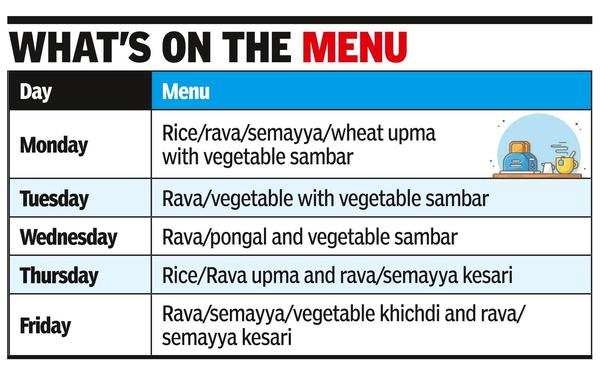
Importance of the breakfast scheme
Reduce child hunger
- Offering breakfast and lunch will give a child almost 28 g of protein and 846 calories per day.
- This will ensure that there is no hunger in the classroom, improving learning outcomes.
Reduce malnutrition
- India has the highest child-wasting rate of any nation included in the Global Hunger Index, at 17.3%.
Boost enrolment numbers
- The promise of food in schools encourages parents to bring their kids to school, especially those from low socioeconomic backgrounds.
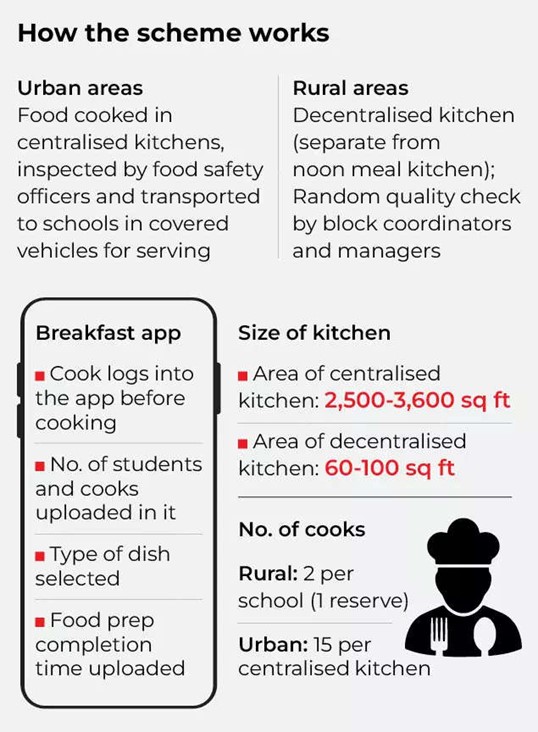
- For instance, Tamil Nadu’s Gross Enrollment Ratio (GER) at primary schools increased following the 1982 implementation of the midday meal programme.
Boost educational results
- According to a government poll, more than 25% of students don’t have breakfast before going to school.
- Making sure that breakfast is served regularly in schools’ benefits pupils by improving their concentration, learning, and memory.
Overcome the effects of Covid
- Children’s learning and nutritional outcomes have significantly decreased since the epidemic years.
- Innovative measures, such as breakfast programmes, are crucial to overcoming obstacles.
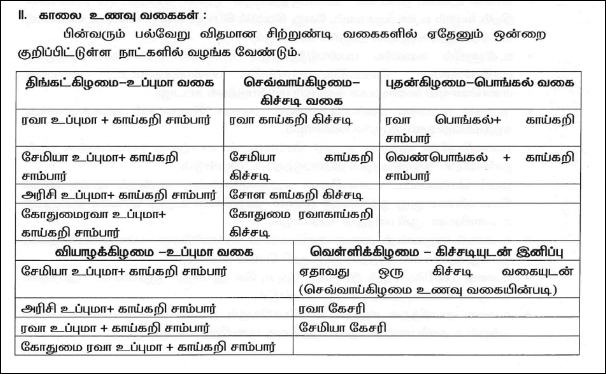
State responsibility
- According to Article 38, the States are responsible for promoting welfare and minimizing income, facility, and opportunity disparities among people and groups.
Combating child labour
- School meals encourage students to stay in school, which lowers the demand for child labour.
Socialization
- It aims at eroding caste stereotypes and class disparities through the shared experience of a meal.
Socio political developments around the scheme
- Political debate on freebies
- Falling human development performance
- Educational disruption caused by COVID-19
- Responsibility of state under Constitution (Article 38).
- To promote welfare and minimize inequalities in income as well as in facilities and opportunities among individuals and groups.
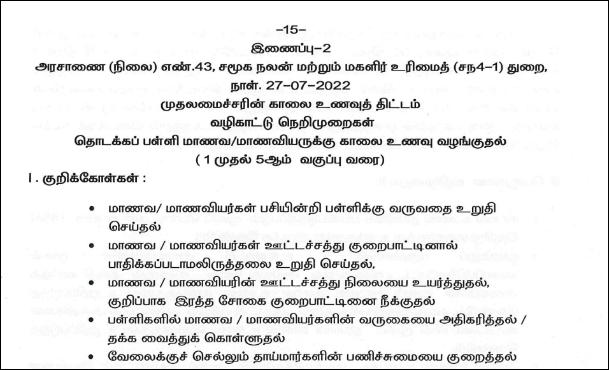
Challenges
- Critics claim that the programme may run into problems like those with the similar Program.
These may consist of
Food of bad quality
- It has been stated that this happens frequently in Midday Meal Scheme.
- Same issues will also arise in this Scheme.
- Examples include serving simple chapatis with salt and cases of food poisoning.
Corruption
- Misappropriation of monies and theft of goods provided under the scheme remain problems.
- For instance, schools in Odisha recently reported a shortage of 4-5 kg of grains in each gunny sack with a 50 kg capacity.
Cultural considerations
- Because of stringent religious and caste beliefs, dietary choices in such programmes can draw criticism.
- For instance, several states have been hesitant to include eggs on the menu for school lunches.
- Children have also occasionally been forced to sit in different classrooms based on their caste status.
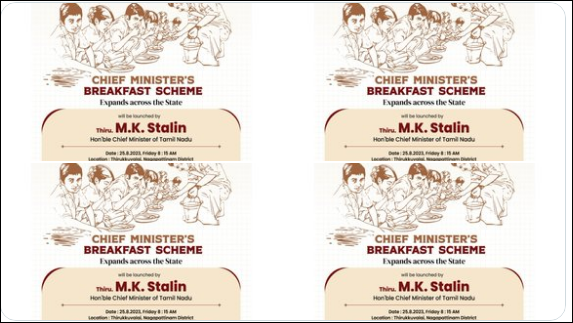
Delays in sanctioning funds
- Teachers have been feeding the kids out of their own pockets or on credit because of the delays in payment.
- The cooks and helpers are not categorized as workers but rather as honorary workers.
- Because of this, the minimum wage laws do not apply to them.
- Most mid-day meal chefs earned less than Rs 2000 per month as a result.
- Same kind of issue also will arise breakfast scheme.
Welfare status of India
Global Food Security Index
- India is ranked 71 out of 113 countries
Global Hunger Index
- 101 out of 116 countries
Human Development Index
- 132 out of 191 countries
Schooling
- India’s mean years of schooling stood at just 7 (6.7) years in 2020-21.
Inequality in education
- India has among the highest levels of inequality in education.
Credit Suisse report
- Rising wealth inequality.
Stunted
- It is defined as low height-for-age.
- It is the result of chronic or recurrent under nutrition.
- About 10% of children aged 5-9 years were stunted in 2018, much lower than the all-India average of 22% and marginally lower than Kerala’s average (11%).
Underweight
- It is defined as low weight-for-age.
- A child who is underweight may be stunted, wasted or both.
- Marginally higher level of underweight children (23%) than Kerala (21%), but this was lower than the national average (35%).
Malnutrition
- 19% of children were malnourished (BMI for age), which was higher than the 16% in Kerala but lower than the national average (23%).
- It refers to deficiencies or excesses in nutrient intake, imbalance of essential nutrients or impaired nutrient utilization.
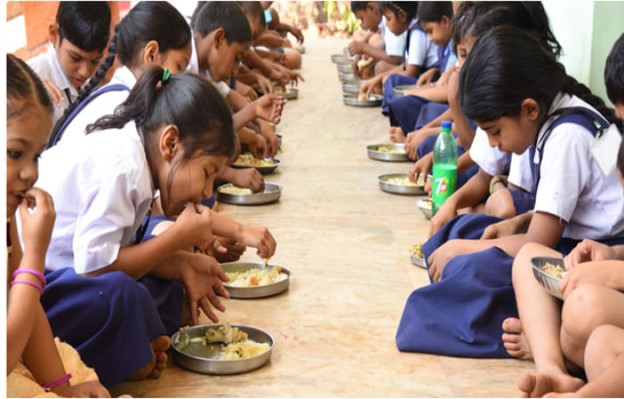
Anemia
- About 10% and 7% were anemic and deficient in Vitamin A, respectively, whereas 41% were deficient in Vitamin D.
- It is a condition in which the number of red blood cells or their oxygen-carrying capacity is insufficient to meet physiological needs.
Freebies
- Any public policy intervention that doesn’t support medium-term to long-term production and productivity may be termed as a freebie.
- Free electricity, free water, free public transportation, waiver of pending utility bills are examples.
- It is farm loan waivers are often regarded as freebies.
- This scheme also considered as freebies.
Way forward
- There is an urgent need for implementing innovative and effective welfare schemes to address the disruptions caused by the pandemic in the education.
- It is helping nutrition sectors and strengthens these sectors.
Initiatives

- Such as Illam Thedi Kalvi and Ennum Ezhuthum were positive attempts in the education sector.
Studies from other countries
- Free breakfast schemes might help increase educational outcomes.
- It is likely increase in school attendance and improved concentration on studies.
- The Department of Agriculture of the United States of America has launched breakfast programmes in schools in numerous states.
- Such programmes were also implemented in several European nations, notably France three years ago.
Impact on school education

Rise in enrolment
- After the improved version of the mid-day meal scheme in 1982 the Gross Enrollment Ratio (GER) at primary level (standards I to V) went up by 10% during July-September, 1982.
- It is compared with the corresponding period in 1981.
- In future this scheme also increases it.
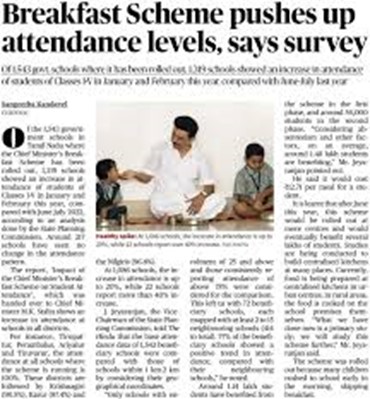
Where should the programme focus more?
- Anaemia is a major health problem in Tamil Nadu, especially among women and children.
- It was said by the 2019-21 National Family Health Survey (NFHS)-5’s report.
- From 50% during the period of the 2015-16 NFHS-4, the prevalence of Anaemia in children now went up to 57%.
- This and many other health issues can be addressed through the combined efforts of the departments of School Education, Public Health and Social Welfare and Women Empowerment.
- Based on expert advice, those in charge of the implementation of the ICDS and the nutritious meal programme can enhance the component of nutrition to those children having specific problems.
- The latest Breakfast Scheme is a step in this direction.
- The breakfast scheme caters to 1,14,095 primary school students from 1,545 government school
- It is important to consider T.N.’s performance because the breakfast scheme is being offered as a first-of-its-kind programme.
- However, the government, which has decades of expertise managing the mid-day meal programme.
- They must avoid the mistakes that have previously presented obstacles in its way.
It can be implemented in other states
- An interesting feature of this scheme is the cost-effective delivery of the service as it is complementary to the existing schemes.
- Further, the income of the Anganwadi workers substantially increased on account of multiple roles played by them.
- In the same way, the morning breakfast scheme makes use of the physical infrastructure (like cooking place and utensils) built for mid-day meals scheme.
Leave a Reply
Your Comment is awaiting moderation.


